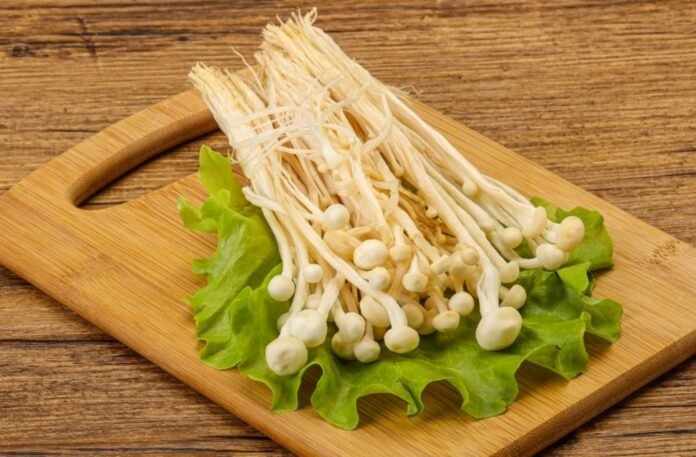What Are Enoki Mushrooms?
A Quick Introduction
Enoki mushrooms, moreover known as Flammulina velutipes, are a sort of consumable organism with tall, lean stems and little white caps. In case mushrooms had a mold week, these would certainly walk the runway.
Scientific Classification
Kingdom: Fungi
Genus: Flammulina
Species: F. velutipes
These mushrooms are broadly utilized in East Asian cooking and are prized for their firm surface and unnoticeable flavor.
Where Do Enoki Mushrooms Come From?
Characteristic Living space
Within the wild, enoki mushrooms develop on the stumps of trees like hackberry or Chinese elm. They’re more often than not found amid the cooler months and have a browner, more smooth appearance than their developed cousins.
Development Nowadays
Much appreciated to advanced cultivating strategies, enoki mushrooms are presently developed inside beneath low-light and high-carbon-dioxide conditions. This keeps them pale, slim, and photogenic perfect for Instagram and your supper plate.
Identifying Enoki Mushrooms
Appearance
Picture this: a bundle of long, spaghetti-thin white stems topped with tiny white caps. That’s your classic enoki. They usually come grouped together at the base and are often sold that way in supermarkets.
Texture and Taste
Crunchy when raw and silky-soft when cooked. The flavor?Gentle, nearly somewhat fruity, with a unpretentious nuttiness. They’re the tofu of mushrooms soaking up anything flavors you toss at them.
Wellbeing Benefits of Enoki Mushrooms
Wealthy in Supplements
These folks are moo in calories but pack a punch when it comes to nourishment.Think:
B vitamins
Fiber
Antioxidants
Minerals like potassium and iron
Immune-Boosting Properties
We are accepted to bolster safe work. They contain polysaccharides compounds that can offer assistance tweak your safe reaction.
Brain and Heart Health
There’s also research suggesting enokis could help reduce bad cholesterol and inflammation, and even improve cognitive function over time. Fancy that from a mushroom!
Culinary Uses of Enoki Mushrooms
East Asian Cuisine
In Japan, Korea, and China, enoki mushrooms are culinary staples. You’ll discover them in hot pots, miso soup, and indeed kimchi.

Western Fusion Recipes
Chefs in the West are catching on and sneaking enoki into all sorts of dishes.
Soups and Stews
Drop them into broth during the last minute of cooking, and they’ll soften just right.
Stir-fries and Noodles
Quick-fry with garlic, soy sauce, and chili for a executioner side dish.
Servings of mixed greens and Wraps
Crude enoki includes a crunchy astonish to your greens or lettuce wraps.
How to Cook Enoki Mushrooms
Cleaning and Planning
These mushrooms are fragile. Trim the root conclusion, flush delicately beneath cold water, and pat dry. That’s it!
Cooking Tips for Maximum Flavor
Don’t overcook—they lose their texture.
Cook on medium heat to avoid sogginess.
Add at the end of a dish to retain crunch.
How to Store Enoki Mushrooms
Fresh vs Packaged Enoki
Packaged enokis from the store are usually clean and ready to go. But check the label—some might have additives.
Shelf Life and Best Practices
Store them in the fridge in their original packaging or a paper bag. They should last about 7–10 days. Slimy mushrooms? Toss them.
Where to Buy Enoki Mushrooms
Local Grocery Stores
Look in the produce aisle, especially near other specialty mushrooms like shiitake or oyster.
Online Specialty Shops
Can’t find them locally? No worries. Plenty of online Asian markets and gourmet food shops deliver The straight to your door.
Are There Any Risks or Side Effects?
Precautions for Consumption
Always cook your enoki mushrooms. Raw ones may carry bacteria like Listeria, especially if improperly handled.
Common Myths Debunked
Myth: All white enokis are wild.
Truth: Cultivated ones are usually white, while wild enokis are brown and fuzzy.
Myth: They have no flavor.
Truth: They absorb other flavors like little sponges—just give ’em the chance.
Growing Enoki Mushrooms at Home
What You Need to Get Started
Enoki mushroom spawn or growing kit
A plastic container
Sawdust or wood substrate
A cool, dark space
Step-by-Step Growing Guide
Sterilize your container and substrate.
Add the mushroom spawn.
Keep in a cool, humid environment (45–68°F).
Wait 2–3 weeks.
Harvest when stems are long and caps are tight.
It’s oddly satisfying—like gardening but crunchier.
Enoki Mushrooms in Pop Culture
In Anime and Manga
Believe it or not, enokis have made cameos in anime food scenes and manga recipes. They’re often the “cute” mushroom because of their look.
Social Media Food Trends
TikTok chefs are wrapping enokis in bacon, frying them tempura-style, or making “enoki bacon sushi.” And yeah, it’s as delicious as it sounds.
Final Thoughts
So, another time you see these noodle-like mushrooms at the store, don’t pass them by. Enoki mushrooms might see elegant, but they’re pressing flavor, crunch, and nourishment like champs. Whether you’re hurling them into a hot pot, stir-frying them for lunch, or attempting your hand at developing them, enokis are worth the buildup. Furthermore, your taste buds will thank you.
FAQs
1. Can you eat enoki mushrooms crude?
Actually, yes but it’s more secure to cook them to dodge microscopic organisms like Listeria.
2. Are enoki mushrooms great for weight misfortune?
Completely! They’re moo in calories, tall in fiber, and offer assistance keep you full.
3. What do enoki mushrooms taste like?
Gentle, marginally fruity, with a unpretentious nuttiness.They easily absorb surrounding flavors.
4. Can I grow enoki mushrooms indoors?
Yes! They’re actually one of the easier mushrooms to grow at home with a kit.
5. What’s the difference between wild and cultivated enoki?
Wild enokis are darker and fuzzy. Cultivated ones are pale and sleek due to growing conditions.

